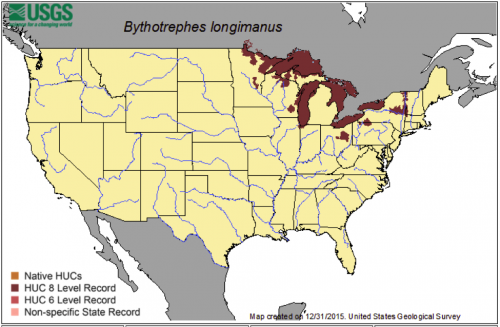National Invasive Species Awareness Week: Spiny waterflea
Part 6 in a series to learn about invasive species and what to do to help protect Michigan and the Great Lakes.

National Invasive Species Week 2016 is February 21-27. Invasive species are plants, animals, and other organisms that are not traditionally found in a given location (in this case the Great Lakes) AND are having a negative impact of some kind, whether ecological, economic, social, and/or a public health threat.
To help bring attention to this week, Michigan State University Extension (MSUE) and Michigan Sea Grant are featuring two different invasive species (one aquatic and one terrestrial species) that have invaded or have the potential to invade Michigan’s environment. Today’s featured aquatic invasive species is the spiny waterflea.
Species Name: Spiny Waterflea (Bythotrephes longimanus)
Description: According to the United States Geological Survey this invasive crustacean is a tiny freshwater species of zooplankton – small animals that rely on water flow and wind to move long distances. The spiny waterflea is distinguished by a single dark compound eye and a long straight tail spine that is twice as long as the rest of its body. The tail is straight or slightly angled with 1-3 barbs along its length. They sometimes have orange, blue or green coloration with a red stripe that runs half the length of the tail.
Similar species: The spiny waterflea is similar to the fishhook waterflea (another non-native species).
Origin: The spiny waterflea is native to Northern Europe and Asia.
How it came to the Great Lakes: Spiny waterfleas likely came to the Great Lakes accidentally in the ballast water of ocean going freighters.
How long it has been here: Spiny waterfleas were first detected in December 1984 in Lake Huron.
Extent of range: Since the first detection in 1984, spiny waterfleas have now been reported in all five Great Lakes and over 100 inland lakes.
Why it is a problem: Spiny waterfleas disrupt the native zooplankton community reducing food supplies for small fish and the young of sport fish such as bass, walleye and yellow perch. Small fish that prey on zooplankton may find the barbs of the spiny waterflea difficult to swallow and often spit it out, causing them to expend important energy resources without gaining nutritional value.
How it is spread: Spiny waterfleas are easily spread between waterbodies on angling equipment and bait buckets and in live wells and bilge waters. They can also spread naturally on water currents between hydrologically connected waterbodies.
A cool/unusual fact: Male and female spiny waterfleas can reproduce both sexually and asexually, often switching between methods depending on the availability of mates.
Management actions/options: As with many aquatic invasive species, once a reproducing population becomes established, management becomes difficult, lengthy, and expensive. Prevention through education, early detection and rapid response to newly forming populations is most effective.
What you can do to help prevent the spread: You can prevent the spread of spiny waterfleas by 1) helping to educate others about identifying and preventing the spread of spiny waterfleas and 2) practicing the Clean, Drain and Dry method for watercraft prior to moving them between lakes. Watch this video.
Michigan Sea Grant helps to foster economic growth and protect Michigan’s coastal, Great Lakes resources through education, research and outreach. A collaborative effort of the University of Michigan and Michigan State University and its MSU Extension, Michigan Sea Grant is part of the NOAA-National Sea Grant network of 33 university-based programs.
Read the aquatic series:
Read the terrestrial series:
Invasive Species Resources:
USGS Spiny Waterflea fact sheet
Ontario’s Invading Species Awareness Program Spiny Waterflea fact sheet
http://www.misin.msu.edu/tools/apps/
http://mnfi.anr.msu.edu/invasive-species/invasives.cfm#publications
http://mnfi.anr.msu.edu/invasive-species/fieldguide.cfm
http://www.glerl.noaa.gov/res/Programs/glansis/
http://www.michigan.gov/dnr/0,4570,7-153-10370_59996---,00.html



 Print
Print Email
Email



